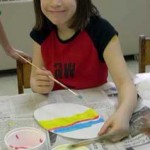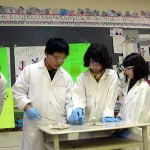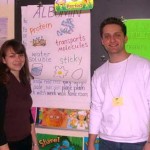Albumin
October 6, 2011 in Protein
On Thursday, March 20th, 2008, the students in Mrs Shuster’s third grade class at École F.A.C.E. School were stuck on “albumin” as university students Christina Thomson (MFA Art Education, Concordia U.) and William Bechara (B.Sc., U. Montréal) presented our sixth Molecules of Life Project (MLP) in Montreal.
Christina and William discussed how like the school bus, albumin can serve as a molecule bus for transporting nutrients, metals, fats and other compounds by way of the blood through the body. Showing a poster to describe the structure and function of albumin, they mentioned how albumin is sticky and can serve like a sponge to absorb different molecules.
As a prelude to an experiment to discuss “solubility”, the students were asked to place “X” marks or check marks on another poster which reviewed laboratory safety practices.
In proper laboratory safety attire, the students performed an experiment to model how albumin can help bring molecules into water and make them “soluble”. First iodine was added to water and remained “insoluble”, sitting like a rock in the bottom of the flask. Then a white powder (the amino acid cysteine) was added to the flask, and within seconds the iodine and powder both went into the water solution which became clear.
Asking students to attach pictures to another set of posters, Christina and William reviewed albumin’s uses in medicine, cooking and art. For example, Doctor’s use albumin to make band-aids stick to skin and to help medicine go into solution. Cooks use the cohesive properties of egg white albumin to make angel-food cake and soufflés.
Moreover, painters such as Sandro Botticelli used egg albumin to make tempera paint pigments more water soluble and more sticky when painting pictures such as “The Birth of Venus” and “La Primavera”.
Inspired by Botticelli and the Easter Bunny, the students used tempera paints to color their own egg shape canvases.
Finally, we discussed the fact that allergies of different foods (i.e., eggs, peanuts, wheat, and milk) may be due to their different forms of albumin.
We thanked Christina and William for today’s MLP presentation which the students sponged-up like albumin.
For more information on albumin see:
http://en.wikipedia.org/wiki/Albumin
On the structure of albumin:
www.friedli.com/research/PhD/chapter5a.html
For details on the things that albumin binds to go to:
For the Botticelli project see:
www.eggtempera.com/botticelli/botticelli.html
On albumin and food allergies see:
http://www.health.discovery.com/centers/allergyasthma/foodallergy/food.html

















